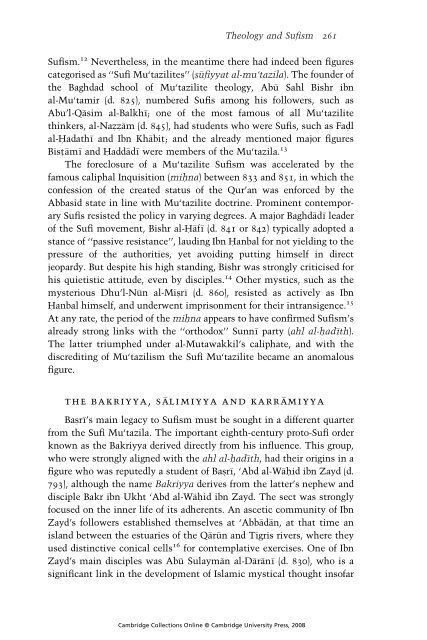Abdal Hakim Murad - The Cambridge Companion to Islamic Theology
You also want an ePaper? Increase the reach of your titles
YUMPU automatically turns print PDFs into web optimized ePapers that Google loves.
<strong>The</strong>ology and Sufism 261<br />
Sufism. 12 Nevertheless, in the meantime there had indeed been figures<br />
categorised as ‘‘Sufi Mu‘tazilites’’ (s _<br />
ufiyyat al-mu‘tazila). <strong>The</strong> founder of<br />
the Baghdad school of Mu‘tazilite theology, Abu Sahl Bishr ibn<br />
al-Mu‘tamir (d. 825), numbered Sufis among his followers, such as<br />
Abu’l-Qasim al-Balkhı; one of the most famous of all Mu‘tazilite<br />
thinkers, al-Naz _<br />
z _<br />
am (d. 845), had students who were Sufis, such as Fad _<br />
l<br />
al-H _<br />
adathı and Ibn Khabit _<br />
; and the already mentioned major figures<br />
Bist _<br />
amı andH _<br />
addadı were members of the Mu‘tazila. 13<br />
<strong>The</strong> foreclosure of a Mu‘tazilite Sufism was accelerated by the<br />
famous caliphal Inquisition (mih _<br />
na) between 833 and 851, in which the<br />
confession of the created status of the Qur’an was enforced by the<br />
Abbasid state in line with Mu‘tazilite doctrine. Prominent contemporary<br />
Sufis resisted the policy in varying degrees. A major Baghdadı leader<br />
of the Sufi movement, Bishr al-H _<br />
afı (d.841 or 842) typically adopted a<br />
stance of ‘‘passive resistance’’, lauding Ibn H _<br />
anbal for not yielding <strong>to</strong> the<br />
pressure of the authorities, yet avoiding putting himself in direct<br />
jeopardy. But despite his high standing, Bishr was strongly criticised for<br />
his quietistic attitude, even by disciples. 14 Other mystics, such as the<br />
mysterious Dhu’l-Nun al-Mis _<br />
rı (d. 860), resisted as actively as Ibn<br />
H _<br />
anbal himself, and underwent imprisonment for their intransigence. 15<br />
At any rate, the period of the mih _<br />
na appears <strong>to</strong> have confirmed Sufism’s<br />
already strong links with the ‘‘orthodox’’ Sunnı party (ahl al-h _<br />
adıth).<br />
<strong>The</strong> latter triumphed under al-Mutawakkil’s caliphate, and with the<br />
discrediting of Mu‘tazilism the Sufi Mu‘tazilite became an anomalous<br />
figure.<br />
the bakriyya, salimiyya and karramiyya<br />
Bas _<br />
rı’s main legacy <strong>to</strong> Sufism must be sought in a different quarter<br />
from the Sufi Mu‘tazila. <strong>The</strong> important eighth-century pro<strong>to</strong>-Sufi order<br />
known as the Bakriyya derived directly from his influence. This group,<br />
who were strongly aligned with the ahl al-h _<br />
adıth, had their origins in a<br />
figure who was reputedly a student of Bas _<br />
rı, ‘Abd al-Wah _<br />
id ibn Zayd (d.<br />
793), although the name Bakriyya derives from the latter’s nephew and<br />
disciple Bakr ibn Ukht ‘Abd al-Wah _<br />
id ibn Zayd. <strong>The</strong> sect was strongly<br />
focused on the inner life of its adherents. An ascetic community of Ibn<br />
Zayd’s followers established themselves at ‘Abbadan,atthattimean<br />
island between the estuaries of the Qarun and Tigris rivers, where they<br />
used distinctive conical cells 16 for contemplative exercises. One of Ibn<br />
Zayd’s main disciples was Abu Sulayman al-Daranı (d.830), who is a<br />
significant link in the development of <strong>Islamic</strong> mystical thought insofar<br />
<strong>Cambridge</strong> Collections Online © <strong>Cambridge</strong> University Press, 2008



